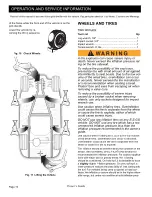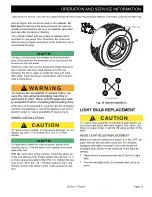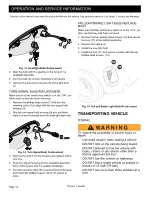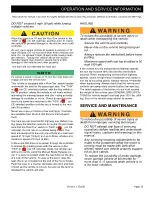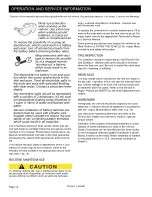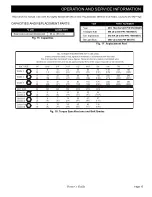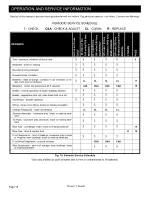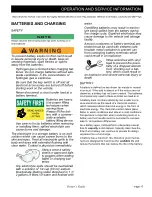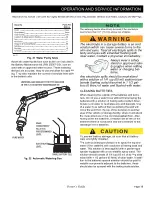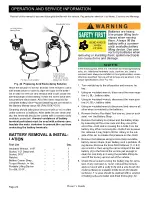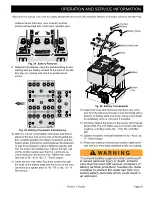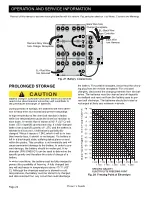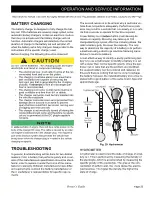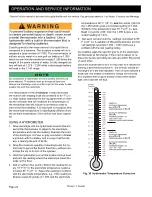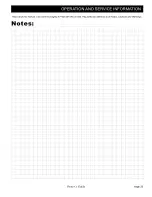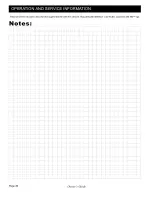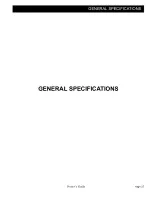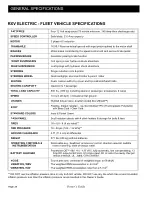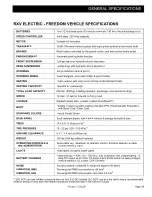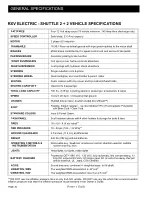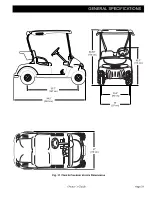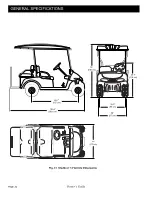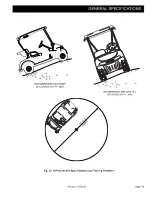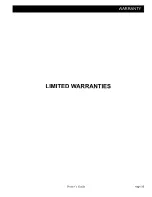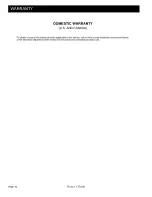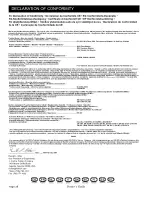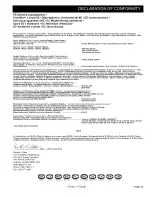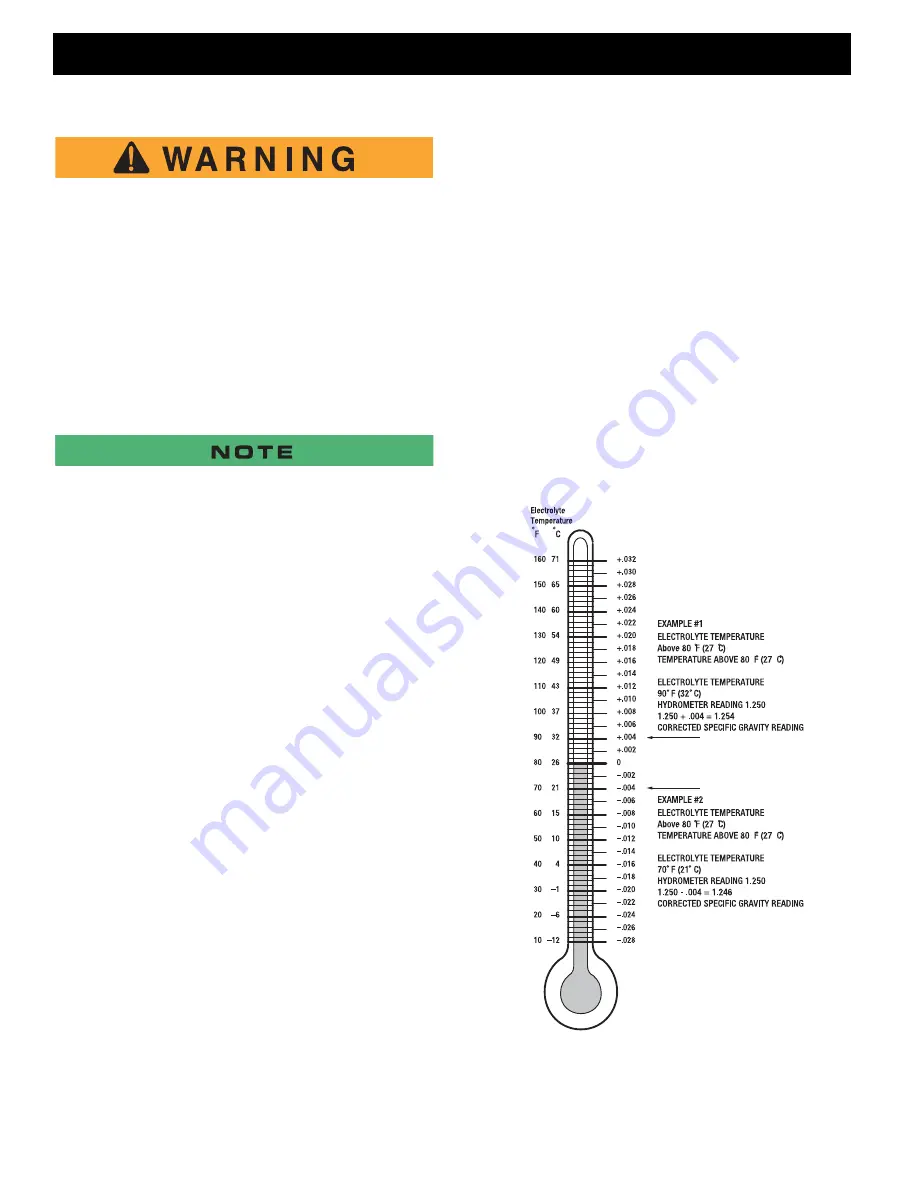
Page 24
OPERATION AND SERVICE INFORMATION
Owner’s Guide
Read all of this manual to become thoroughly familiar with this vehicle. Pay particular attention to all Notes, Cautions and Warnings.
B
To prevent battery explosion that could result
in severe personal injury or death, never insert
a metal thermometer into a battery. Use a
hydrometer with a built in thermometer that is
designed for testing batteries.
Specific gravity is the measurement of a liquid that is
compared to a baseline. The baseline is water which is
assigned a base number of 1.000. The concentration of
sulfuric acid to water in a new golf car battery is 1.280
which means that the electrolyte weighs 1.280 times the
weight of the same volume of water. A fully charged bat-
tery will test at 1.275 - 1.280 while a discharged battery
will read in the 1.140 range.
Do not perform a hydrometer test on a battery that has just
been watered. The battery must go through at least one
charge and discharge cycle in order to permit the water to ade-
quately mix with the electrolyte.
The temperature of the
electrolyte
is important since
the hydrometer reading must be corrected to 80° F (27°
C). High quality hydrometers are equipped with an inter-
nal thermometer that will measure the temperature of
the electrolyte and will include a conversion scale to
correct the float reading. It is important to recognize that
the electrolyte temperature is significantly different from
the ambient temperature if the vehicle has been operat-
ed.
USING A HYDROMETER
1. Draw electrolyte into the hydrometer several times to
permit the thermometer to adjust to the electrolyte
temperature and note the reading. Examine the color
of the electrolyte. A brown or gray coloration indicates
a problem with the battery and is a sign that the bat-
tery is nearing the end of its life.
2. Draw the minimum quantity of electrolyte into the hy-
drometer to permit the float to float freely without con-
tacting the top or bottom of the cylinder.
3. Hold the hydrometer in a vertical position at eye level
and note the reading where the electrolyte meets the
scale on the float.
4. Add or subtract four points (.004) to the reading for ev-
ery 10° F (6° C) the electrolyte temperature is above
or below 80° F (27° C). Adjust the reading to conform
with the electrolyte temperature, e.g., if the reading in-
dicates a specific gravity of 1.250 and the electrolyte
temperature is 90° F (32° C),
add
four points (.004) to
the 1.250 which gives a corrected reading of 1.254.
Similarly if the temperature was 70° F (21° C),
sub-
tract
four points (.004) from the 1.250 to give a cor-
rected reading of 1.246.
5. Test each cell and note the readings (corrected to 80°
F or 27° C). A variation of fifty points between any two
cell readings (example 1.250 - 1.200) indicates a
problem with the low reading cell(s).
As a battery ages the specific gravity of the electrolyte
will decrease at full charge. This is not a reason to re-
place the battery providing all cells are within fifty points
of each other.
Since the hydrometer test is in response to a vehicle ex-
hibiting a performance problem , the vehicle should be
recharged and the test repeated. If the results indicate a
weak cell, the battery or batteries should be removed
and replaced with a good battery of the same brand,
type and approximate age.
Fig. 30 Hydrometer Temperature Correction
Summary of Contents for RXV Fleet Freedom Shuttle 2+2
Page 47: ...Page 27 Owner s Guide GENERAL SPECIFICATIONS GENERAL SPECIFICATIONS...
Page 55: ...Page 35 Owner s Guide WARRANTY LIMITED WARRANTIES...
Page 57: ...Page 37 Owner s Guide DECLARATION OF CONFORMITY DECLARATION OF CONFORMITY EUROPE ONLY...
Page 60: ...Page 40 Owner s Guide DECLARATION OF CONFORMITY...
Page 107: ...Seite 27 ALLGEMEINE TECHNISCHE DATEN ALLGEMEINE TECHNISCHE DATEN Betriebsanleitung...
Page 115: ...Seite 35 GARANTIE Betriebsanleitung BEGRENZTE GEW HRLEISTUNG...
Page 117: ...Seite 37 KONFORMIT TSERKL RUNG Betriebsanleitung KONFORMIT TSERKL RUNG NUR EUROPA...
Page 120: ...Seite 40 KONFORMIT TSERKL RUNG Betriebsanleitung...

